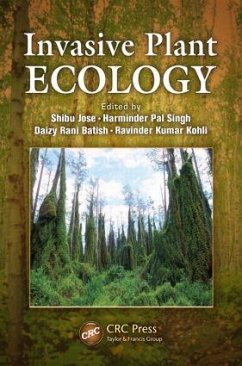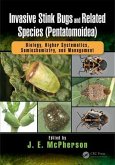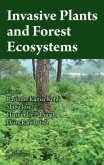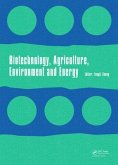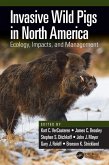Invasive Plant Ecology
Herausgeber: Jose, Shibu; Kohli, Ravinder Kumar; Batish, Daizy Rani; Singh, Harminder Pal
Invasive Plant Ecology
Herausgeber: Jose, Shibu; Kohli, Ravinder Kumar; Batish, Daizy Rani; Singh, Harminder Pal
- Gebundenes Buch
- Merkliste
- Auf die Merkliste
- Bewerten Bewerten
- Teilen
- Produkt teilen
- Produkterinnerung
- Produkterinnerung
Comprising a series of essays from botanical experts across the globe, this reference presents a comprehensive examination of the problem of invasive plant species and their impacts on different ecosystems. Through examination of ecological theories that explain plant invasions, it provides a foundation in invasion ecology. Contributors discuss the role of ecological attributes such as plant life history and fire and management practices with respect to plant invasion. The book examines the physiological basis for invasive species success and gives ecological management and restoration guidelines for invaded areas.…mehr
Andere Kunden interessierten sich auch für
![Invasive Stink Bugs and Related Species (Pentatomoidea) Invasive Stink Bugs and Related Species (Pentatomoidea)]() Invasive Stink Bugs and Related Species (Pentatomoidea)258,99 €
Invasive Stink Bugs and Related Species (Pentatomoidea)258,99 €![Invasive and Introduced Plants and Animals Invasive and Introduced Plants and Animals]() Invasive and Introduced Plants and Animals202,99 €
Invasive and Introduced Plants and Animals202,99 €![Invasive Plants and Forest Ecosystems Invasive Plants and Forest Ecosystems]() Invasive Plants and Forest Ecosystems273,99 €
Invasive Plants and Forest Ecosystems273,99 €![Biotechnology, Agriculture, Environment and Energy Biotechnology, Agriculture, Environment and Energy]() Biotechnology, Agriculture, Environment and Energy352,99 €
Biotechnology, Agriculture, Environment and Energy352,99 €![Invasive Wild Pigs in North America Invasive Wild Pigs in North America]() Invasive Wild Pigs in North America293,99 €
Invasive Wild Pigs in North America293,99 €![Invasive Aliens Invasive Aliens]() Dan EatherleyInvasive Aliens15,99 €
Dan EatherleyInvasive Aliens15,99 €![Ecological Processes Handbook Ecological Processes Handbook]() Luca PalmeriEcological Processes Handbook228,99 €
Luca PalmeriEcological Processes Handbook228,99 €-
-
-
Comprising a series of essays from botanical experts across the globe, this reference presents a comprehensive examination of the problem of invasive plant species and their impacts on different ecosystems. Through examination of ecological theories that explain plant invasions, it provides a foundation in invasion ecology. Contributors discuss the role of ecological attributes such as plant life history and fire and management practices with respect to plant invasion. The book examines the physiological basis for invasive species success and gives ecological management and restoration guidelines for invaded areas.
Hinweis: Dieser Artikel kann nur an eine deutsche Lieferadresse ausgeliefert werden.
Hinweis: Dieser Artikel kann nur an eine deutsche Lieferadresse ausgeliefert werden.
Produktdetails
- Produktdetails
- Verlag: CRC Press
- Seitenzahl: 302
- Erscheinungstermin: 9. Januar 2013
- Englisch
- Abmessung: 257mm x 180mm x 23mm
- Gewicht: 748g
- ISBN-13: 9781439881262
- ISBN-10: 143988126X
- Artikelnr.: 36609118
- Herstellerkennzeichnung
- Libri GmbH
- Europaallee 1
- 36244 Bad Hersfeld
- gpsr@libri.de
- Verlag: CRC Press
- Seitenzahl: 302
- Erscheinungstermin: 9. Januar 2013
- Englisch
- Abmessung: 257mm x 180mm x 23mm
- Gewicht: 748g
- ISBN-13: 9781439881262
- ISBN-10: 143988126X
- Artikelnr.: 36609118
- Herstellerkennzeichnung
- Libri GmbH
- Europaallee 1
- 36244 Bad Hersfeld
- gpsr@libri.de
Shibu Jose, Ph.D., an applied ecologist, is the H.E. Garrett Endowed Professor in the School of Natural Resources and director of the Center for Agroforestry at the University of Missouri. He is the editor-in-chief of Agroforestry Systems and associate editor of the International Journal of Ecology and the Journal of Forestry. Dr. Jose's research program studies key ecological processes and interactions that define ecological sustainability. He examines how resource availability and disturbances influence ecosystem structure and uses the information in designing agroforestry systems and restoring degraded and damaged ecosystems. Dr. Jose and his research team have conducted studies in the United States, Australia, Costa Rica, Belize, Bangladesh, Panama, and India. He has more than 150 publications, including 6 edited books and 3 special issues. Harminder Pal Singh, Ph.D., an ecophysiologist, is an assistant professor in the Department of Environmental Studies at Panjab University, Chandigarh, India. His research interests include examining the ecophysiological basis of plant interactions, evaluating the impact of exotic invasive plants on structural and functional aspects of native ecosystems, and exploring the role of natural plant products as novel pesticides. His research findings have resulted in 75 research papers in refereed journals and 6 edited books. Daizy R. Batish, Ph.D., is a professor in the Department of Botany at Panjab University, Chandigarh, India. Over the past 20 years, Dr. Batish and her research group have been involved in studying the biology and ecology of invasive weeds, ecophysiology of plant-plant interactions, and ecological weed management. Her research program aims at identifying and evaluating plant products with potential application as novel herbicides under sustainable agriculture. Dr. Batish has published over 100 research papers in refereed journals, 6 books, and 40 research articles. Ravinder Kumar Kohli, Ph.D., a certified senior ecologist of the Ecological Society of America and JC Bose National Fellow of the Government of India, is the senior-most professor and Dean University Instruction at Panjab University, Chandigarh, India. He is a fellow of all four national official Indian academies of science. He is the coordinator of IUFRO unit 8.02.04-Ecology of Alien Invasives and 4.02.02-Multipurpose Inventories. Dr. Kohli's research career of 32 years remains focused on the ecological implications of introduced alien trees and invasive alien plants in India. He is on the editorial boards of several journals devoted to crop production, ecology, and the environment and a reviewer of several international journals. He has published approximately 260 research papers, including 12 books.
Invasive plant ecology: The horse behind the cart? What makes the alien
plants so successful? Exploration of the ecological basis. Novel weapon
hypothesis for the successful establishment of invasive plants in alien
environments: A critical appraisal. Functional basis for geographical
variation in growth among invasive plants. Aboveground-belowground
interactions: Implication for invasiveness. From species coexistence to
genotype coexistence: What can we learn from invasive plants? Mycorrhizae
and invasive plants. Exotic plant response to forest disturbance in the
western United States. Effects of silvicultural practices on invasive plant
species abundance in the Missouri Ozark forests of the central United
States. Invasive plants and mutualistic interactions between fleshy fruits
and frugivorous animals. Alien plant invasion and its ecological
implications: An Indian perspective with particular reference to
biodiversity-rich regions. Impact of invasive alien plant species on
aboveground and belowground diversity in the Kashmir Himalaya, India.
Ecology and management of invasive plants in Africa. Geospatial tools for
identifying and managing invasive plants. Improving restoration to control
plant invasions under climate change. Converting invasive alien plant
stands to natural forest nature's way: Overview, theory, and practice.
Economics of invasive plant management. An economic analysis of the
invasive plant problem associated with the horticulture industry in North
America. Index.
plants so successful? Exploration of the ecological basis. Novel weapon
hypothesis for the successful establishment of invasive plants in alien
environments: A critical appraisal. Functional basis for geographical
variation in growth among invasive plants. Aboveground-belowground
interactions: Implication for invasiveness. From species coexistence to
genotype coexistence: What can we learn from invasive plants? Mycorrhizae
and invasive plants. Exotic plant response to forest disturbance in the
western United States. Effects of silvicultural practices on invasive plant
species abundance in the Missouri Ozark forests of the central United
States. Invasive plants and mutualistic interactions between fleshy fruits
and frugivorous animals. Alien plant invasion and its ecological
implications: An Indian perspective with particular reference to
biodiversity-rich regions. Impact of invasive alien plant species on
aboveground and belowground diversity in the Kashmir Himalaya, India.
Ecology and management of invasive plants in Africa. Geospatial tools for
identifying and managing invasive plants. Improving restoration to control
plant invasions under climate change. Converting invasive alien plant
stands to natural forest nature's way: Overview, theory, and practice.
Economics of invasive plant management. An economic analysis of the
invasive plant problem associated with the horticulture industry in North
America. Index.
Invasive plant ecology: The horse behind the cart? What makes the alien
plants so successful? Exploration of the ecological basis. Novel weapon
hypothesis for the successful establishment of invasive plants in alien
environments: A critical appraisal. Functional basis for geographical
variation in growth among invasive plants. Aboveground-belowground
interactions: Implication for invasiveness. From species coexistence to
genotype coexistence: What can we learn from invasive plants? Mycorrhizae
and invasive plants. Exotic plant response to forest disturbance in the
western United States. Effects of silvicultural practices on invasive plant
species abundance in the Missouri Ozark forests of the central United
States. Invasive plants and mutualistic interactions between fleshy fruits
and frugivorous animals. Alien plant invasion and its ecological
implications: An Indian perspective with particular reference to
biodiversity-rich regions. Impact of invasive alien plant species on
aboveground and belowground diversity in the Kashmir Himalaya, India.
Ecology and management of invasive plants in Africa. Geospatial tools for
identifying and managing invasive plants. Improving restoration to control
plant invasions under climate change. Converting invasive alien plant
stands to natural forest nature's way: Overview, theory, and practice.
Economics of invasive plant management. An economic analysis of the
invasive plant problem associated with the horticulture industry in North
America. Index.
plants so successful? Exploration of the ecological basis. Novel weapon
hypothesis for the successful establishment of invasive plants in alien
environments: A critical appraisal. Functional basis for geographical
variation in growth among invasive plants. Aboveground-belowground
interactions: Implication for invasiveness. From species coexistence to
genotype coexistence: What can we learn from invasive plants? Mycorrhizae
and invasive plants. Exotic plant response to forest disturbance in the
western United States. Effects of silvicultural practices on invasive plant
species abundance in the Missouri Ozark forests of the central United
States. Invasive plants and mutualistic interactions between fleshy fruits
and frugivorous animals. Alien plant invasion and its ecological
implications: An Indian perspective with particular reference to
biodiversity-rich regions. Impact of invasive alien plant species on
aboveground and belowground diversity in the Kashmir Himalaya, India.
Ecology and management of invasive plants in Africa. Geospatial tools for
identifying and managing invasive plants. Improving restoration to control
plant invasions under climate change. Converting invasive alien plant
stands to natural forest nature's way: Overview, theory, and practice.
Economics of invasive plant management. An economic analysis of the
invasive plant problem associated with the horticulture industry in North
America. Index.

